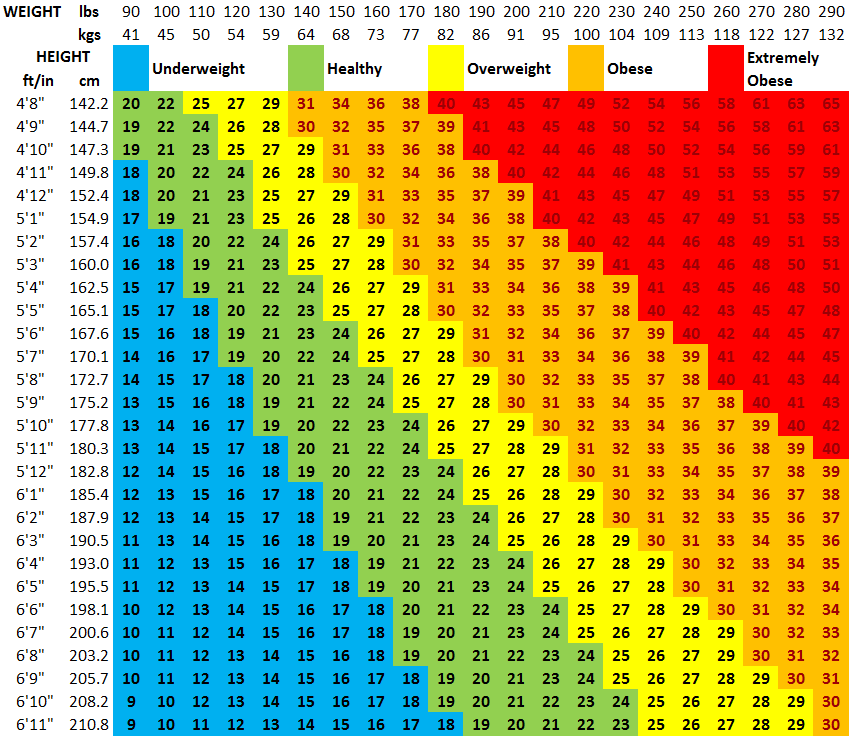It’s time to move beyond BMI

Posted on
Have you ever taken a ‘simple’ BMI test only to be told that your ideal weight is a number that you haven’t been since you were 13?
How frustrating! And confusing…and then, disheartening.
The BMI may be the easiest way to measure the weight status of an entire population, but it’s definitely not the best way to measure an individual. Here’s the low-down.
What is the BMI?
The BMI stands for Body Mass Index. It’s a weight to height ratio and it’s calculated by dividing an individual’s weight in kg by their height in cm squared.
This calculation will give the individual a single number between 18 to 40 and based on this number you are classified into one of four groups:
- < 18 = underweight
- 18 – 25 = healthy weight
- 25-30 = overweight
- 30 – 35 = obese
- 35 = morbidly obese
The other way that it’s used, is to inform individuals of their ideal weight based on their height.
For example, the BMI chart below will give you your ‘ideal’ weight range (green) based on your height. Find your height down the left-hand side and you’ll see your ideal weight range in the green squares.

Image via bmicalculator.mes.fm/bmi-chart.
Unfortunately, this method doesn’t give everyone an accurate or achievable ideal weight.
Why is it used?
If I were writing an academic paper, this is what I would write:
The Body Mass Index (BMI) is the dominant means of defining and diagnosing obesity in national and international public health policy.
Yeah, that’s a bit dry…
In normal language, the BMI is the easiest, cheapest and simplest way to measure a person’s ‘fatness’ and their subsequent risk of morbidity (sickness) and mortality (death) from lifestyle-related diseases.
The truth is, it’s not completely redundant. It can predict an individual’s fatness to a degree of certainty, however, because it doesn’t take into account anything more than weight and height, it should be taken with a grain of salt.
What the BMI doesn’t measure is body composition. It has no way of identifying the amount of muscle, fat, water and skeleton and individual has. Studies also show that the BMI is influenced by age and sex; which makes sense, as these two factors both affect body composition in various ways.
The main arena where BMI has value is in population research. It’s much easier (and cheaper) to collect data on the weight and height of thousands of people than it is to weigh them underwater, measure their body fat with skinfold callipers or scan them with bioelectrical impedance—all much more accurate ways of measuring body fatness.
And because BMI can predict fatness reasonably well, using it to assess risk for chronic disease or associating it with certain behaviours or dietary patterns can give us some insight into different population groups across the globe.
The results of all these studies help shape nutrition recommendations and public health policy. Here’s one example of the many ways the BMI is used in research:

You can see from this graph, that for a population, as the BMI increases so too does the frequency of lifestyle diseases like high blood pressure and diabetes.
Why should you ignore it?
Even though BMI is reasonably good at predicting body fatness, it’s definitely not foolproof and is a somewhat redundant measure for assessing an individual and their needs when it comes to their nutrition, long term weight management and health.
In saying that, when it comes to health recommendations, the BMI was never intended to be used alone. We need to see a person’s life more holistically.
Here’s a good example: Let’s compare two men. They’re both 180cm tall and each weighs 100kg. Their BMIs are 31, classifying them as obese.
Man no. 1 has only 12% body fat with a large amount of skeletal muscle. He weight-trains regularly and has been active for years. His visceral (tummy) fat is minimal as reflected by his waist to hip ratio (another measure of fatness) and his body composition scan (yet another measure of fatness).
Man no. 2 is 30% body fat. He has a lower muscle mass, a sedentary job, hasn’t exercised regularly in years and has a waist to hip ratio well over 1 indicating a high amount of fat stored around his abdomen.
Both men are obese according to their BMI, however, which man is at increased risk of lifestyle-related diseases? You are correct, Man no. 2. And the BMI could not have predicted that.
What should I do instead?
There are a number of ways you can measure your level of body fatness, with varying levels of accuracy.
If you’re looking to lose weight, you’ll want to stick to one method of measuring so you can compare yourself to yourself to track your progress more consistently.
You shouldn’t compare skin folds with a DEXA scan. Here are all the ways you can estimate your body composition.
- Skinfold calipers
- InBody 570 machine
- Underwater weighing
- DEXA scan
If you’re not sure what you’re ideal weight is and the BMI tells you something ludicrous, then my advice would be to stop stressing over getting your weight to a perfect number.
Your weight and body fat is only ONE factor of your health. Your daily eating habits, your exercise levels, whether you drink alcohol regularly, smoking, all affect your long term health too.
I’d also argue that your ideal weight is the weight where you feed your body well, exercise daily and feel comfortable in your own skin.
If you have to starve yourself, flog yourself in the gym for hours on end and go to drastic measures to attain it, then the number you’re striving for is NOT your ideal weight.
If you’re tired of unrealistic diet and looking for a sustainable approach, then check out my new program, The Hub Membership.
I created this program to help people who are struggling with their eating habits and want to lose weight, feel good and eat well for the rest of their life by teaching them one habit at a time and helping them apply key nutrition principles to their individual life, unlike other online programs that expect you to change everything all at once! Find out more here.


Leave a Reply
You must be logged in to post a comment.